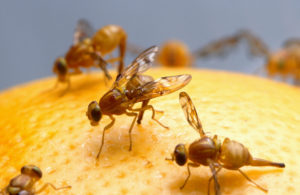07
Jun
Insecticide-Resistant Fruit Flies Show Reproductive Difficulties
(Beyond Pesticides, June 7, 2017) Fruit flies that developed a genetic resistance to the insecticide DDT have lower success at mating than those without similar changes, according to a study published last month in the journal Behavior Genetics. The results were surprising to researchers, given that the resistance developed through changes to a single allele (a variation of a single gene). “It is amazing that even if all the genes are exactly the same, having this one gene expressed at a higher level has all these effects,” said Professor Nina Wedell, PhD, of the Centre for Ecology and Conservation on Exeter’s Penryn Campus in Cornwall, UK to Phys.org. The study raises possible concerns about the effect of pesticide exposure to non-target (not the focus of pesticide use) insects that are integral to a healthy ecology and food web.
 In conducting their investigation, researchers studied the biological fitness costs associated with the development of an insecticide resistance gene. After scientists bred resistant flies in the lab, they set up a series of “competitive mating trials,” comparing both courtship behavior and the impact of size on male fruit flies’ mating success. In general, resistant males were found to be smaller than flies that did not contain the genetic variation. However, even when larger than non-resistant males, insecticide-resistant fruit flies were less likely to be successful in the study’s competitive mating trials.
In conducting their investigation, researchers studied the biological fitness costs associated with the development of an insecticide resistance gene. After scientists bred resistant flies in the lab, they set up a series of “competitive mating trials,” comparing both courtship behavior and the impact of size on male fruit flies’ mating success. In general, resistant males were found to be smaller than flies that did not contain the genetic variation. However, even when larger than non-resistant males, insecticide-resistant fruit flies were less likely to be successful in the study’s competitive mating trials.
While researchers indicate size played an important role in differences between mating success, they note a number of other factors were also at play. In addition to being smaller, males carrying the resistance allele also chased females and performed courtship displays at a lower rate. And after they performed a courtship display, they were less likely to make an attempt to mate. In addition, these males waited more than two times as long as non-resistant males before mating, a term called “copulation latency,” indicating that resistant males were less attractive to females.
In sum, Dr. Wedell said to Phys.org, “The expression level of one gene responsible for detoxifying DDT also makes males smaller, less aggressive and rubbish at courting.” While the observations were clear, the mechanism through which this genetic variation resulted in the changes were less so. “We don’t yet know how this comes about,” Dr. Wedell indicated.
Although DDT is no longer in use, insecticide resistance among pests is widespread. Reports indicate that the vast majority of lice are resistant to common insecticide treatment, including the use of new chemical class insecticides, such as the synthetic pyrethroids. Indeed, 99.6% of lice are resistant to chemical treatment. Similarly, scientific studies have found bed bugs to also be resistant to commonly used insecticides. If the current study’s results are able to be translated to other insect pests, it may seem to be a beneficial on the whole by lowing a pest’s reproductive fitness. However, it should be noted that the documented effects in this study are only seen in the absence of insecticide exposure. When insecticides are present, non-resistant fruit flies die out, leaving less fit males free reign to mate. Indeed, if translatable to other insects and pesticides, this study raises concerns about the fitness of non-target, beneficial organisms that may develop resistance as a result of pesticide drift or location-based exposure.
For nearly every pest problem, there are a range of alternative methods to address the issue without resorting to the use of toxic pesticides with a range of unknown and concerning effects on the environment, wildlife and public health. For more information on managing pests without hazardous chemicals see Beyond Pesticides ManageSafe webpage, which provides information for inside homes and structures, and outdoor gardens, lawns, and landscapes.
All unattributed positions and opinions in this piece are those of Beyond Pesticides.
Source: Phys.org










